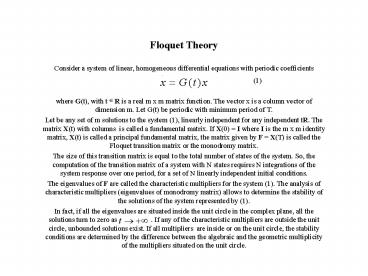Floquet Theory
1 / 3
Title: Floquet Theory
1
- Floquet Theory
- Consider a system of linear, homogeneous
differential equations with periodic coefficients
- (1)
- where G(t), with t R is a real m x m matrix
function. The vector x is a column vector of
dimension m. Let G(t) be periodic with minimum
period of T. - Let be any set of m solutions to the system (1),
linearly independent for any independent tR. The
matrix X(t) with columns is called a fundamental
matrix. If X(0) I where I is the m x m identity
matrix, X(t) is called a principal fundamental
matrix, the matrix given by F X(T) is called
the Floquet transition matrix or the monodromy
matrix. - The size of this transition matrix is equal to
the total number of states of the system. So, the
computation of the transition matrix of a system
with N states requires N integrations of the
system response over one period, for a set of N
linearly independent initial conditions. - The eigenvalues of F are called the
characteristic multipliers for the system (1).
The analysis of characteristic multipliers
(eigenvalues of monodromy matrix) allows to
determine the stability of the solutions of the
system represented by (1). - In fact, if all the eigenvalues are situated
inside the unit circle in the complex plane, all
the solutions turn to zero as .
If any of the characteristic multipliers are
outside the unit circle, unbounded solutions
exist. If all multipliers are inside or on the
unit circle, the stability conditions are
determined by the difference between the
algebraic and the geometric multiplicity of the
multipliers situated on the unit circle.
2
- Recurrence Analysis
- Recurrence Plot
- The RP is a two dimensional representation of
single trajectory. It is formed by a
2-dimensional M x M (matrix) where M is the
number of embedding vectors Y(i) obtained from
the delay co-ordinates of the input signal. In
the matrix the point value of coordinates (i,j),
is the Euclidean distances between vectors Y(i)
and Y(j). In this matrix horizontal axis
represents the time index Y(i) while the vertical
one represents the time shift Y(j). A point is
placed in the array (i,j) if Y(i) is sufficiently
close to Y(j). A point is placed in the array
(i,j) if Y(i) is sufficiently close to Y(j).
There are two type of RP thresholded ( also known
as recurrence matrix) and unthresholded. The
thresholded RPs are symmetric around the main
diagonal (45 axis). - In an unthresholded PR the pixel lying at (i,j)
is colored-coded according to the distance, while
in a thresholded RP the pixel lying at (i,j) is
black if the distance falls within a specified
threshold corridor and white otherwise. - The recurrence matrix is symmetric across its
diagonal if Y(i)-Y(j)Y(j)-Y(i). - The points in this array are colored according
to the vectors distance . Usually the
dark colour shows the long distances and light
colour short one. If the texture of the pattern
within such a block is homogeneous, stationarity
can be assumed for the given signal within the
corresponding period of time non-stationary
systems causes changes in the distribution of
recurrence points in the plot which is visible by
brightened areas
3
- Recurrence Analysis
- Recurrence Quantification Analysis
- The RPs approach for its graphical output is not
easy to interpret. As consequence Zbilut et alt.
(1998) proposed statistical quantification of
RPs, well-know as Recurrence Quantification
analysis (RQA). - RQA defines measures for diagonal segments in a
recurrence plots. These measures are recurrence
rate, determinism, averaged length of diagonal
structures, entropy and trend. - Recurrence rate (REC) is the ratio of all
recurrent states (recurrence points percentage)
to all possible states and is the probability of
recurrence of a special state. REC is simply what
is used to compute the correlation dimension of
data. - Determinism (DET) is the ratio of recurrence
points forming diagonal structures to all
recurrence points. DET measures the percentage of
recurrent points forming line segments which are
parallel to main diagonal. These line segments
show the existence of deterministic structures,
the absence, instead randomness. - Maxline (MAXLINE) represents the averaged length
of diagonal structures and indicates longest line
segments which are parallel to main diagonal.
They are claimed to be proportional to inverse of
the largest positive Lyapunov exponent. A
periodic signal produces long line segments,
while the noise doesn't produce any segments.
Short segments indicate chaos. - The entropy (ENT) measures the distribution of
those line segments which are parallel to main
diagonal and reflects the complexity of the
deterministic structure in the system. High value
of ENT are typical of periodic behaviors while
low values of chaotic behaviors ones. - The value trend (TREND) measures the paling of
the patterns of RPs away from the main diagonal
(used for detecting drift and non-stationarity in
a time series).































